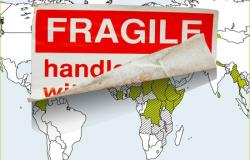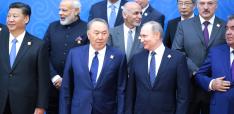Aid’s Fragile State Problem – Why is it So Hard to Even Think About?

Duncan Green explores the aid sector's enduring blind spot.
I’ve spotted a recurring problem with the way the aid sector talks about fragile and conflict-affected states (FCAS). FCAS are characterized by states that are either absent or predatory – in terms of development, governments and officials are as likely to be part of the problem as part of the solution.
But the aid sector, especially the official world of bilateral and multilateral organizations, traditionally relies on the state as the main channel for spending aid dollars to provide education, health or the rule of law. Its instincts are statist. Aid wallahs can’t seem to cope when that recipe doesn’t work, and when confronted with FCAS, it often suffers some kind of intellectual loss of nerve where it ends up ‘assuming a state’ when discussing the role of aid. With a functioning (if imaginary) state, suddenly we can have all those comforting aid discussions about how it should best spend money, build schools etc etc. Most odd.
I mentioned this phenomenon in my review of a recent LSE-hosted ‘Commission on Fragility and Growth’, but it cropped up again in a recent ODI report on ‘financing the end of extreme poverty’.
Before it defaults back to a fictitious state, the report crunches some useful numbers. It projects poverty numbers out to 2030 and looks at what might ensure that the world ‘gets to zero’. It uses IMF and World Bank estimates of what states can reasonably be expected to raise in tax revenues and costs how much states need to spend to provide universal education and healthcare and on social protection to get everyone above $1.90 a day.
Key findings:
The proportion of people living in extreme poverty across the world is projected to fall from the latest estimate of 11% to 5% in 2030 as a result of economic growth. This would see 400 million people lifted out of extreme poverty ($1.90 a day), but leave another 400 million still in extreme poverty in 2030.
Of these 400 million people, 85% will be in fragile states.

Low Income Countries (LICs) will have 54% of the global total of extremely poor people (some fragile states are actually middle income, hence the difference between the numbers).
On average, LICs could only increase their revenues from 17% to 19% of gross domestic product. The rest is going to have to come from aid.
While additional tax revenue reduces their funding gaps, 48 of the poorest countries in the world still cannot afford to fully fund the three core social sectors needed to end extreme poverty even if they maximise their tax effort. They would still face an aggregate financing gap of $150 billion a year. Of these, there are 29 severely financially challenged countries (SFCCs) that cannot even afford half the costs.
The 48 under-resourced countries are predominantly low-income, least developed and fragile states. The concentration is even more pronounced in the 29 SFCCs: all bar one of the 29 is a LIC or a least developed country (LDC), and only three are not fragile states.
This is where alarm bells began to ring: 26/29 of the SFCCS are fragile and/or conflict affected, and the answer is – more aid. To whom? To do what? Isn’t the politics of these places rather important in determining how much of the aid ends up reducing poverty?
I’m a big fan of the ODI so sent this draft post over to Marcus Manuel, who wrote the report. He pushed back with two good points:
‘First I agree I don’t talk about how to spend the money and that is really important. But I think there are wide range of instruments that have been used and could be used. Failing all else, Social Protection could be done entirely by the UN and CSOs – i.e. we treat this as a humanitarian emergency. And you do see external money well spent in FCAS – the Afghanistan reconstruction trust fund, Liberia pooled health fund and Yemen social development fundto name but three. I agree these countries face deep governance problems – but there are hybrid ways of ensuring money for basic services is delivered and benefits the poorest.
Second, the aim of my paper was to sound the alarm – yet again – that donors are switching their money away from LICS/LDCS (low income and least developed countries) to countries that serve their national interest. Do critique me but please don’t let the donors off the hook. We can discuss and debate how best to spend the money but without the money we will all be unable to help.’
This is really useful and links nicely back to the work I’m doing on Public Authority at the LSE – trying to understand how power and politics actually works in precisely these countries that ODI labels as ‘SFCCs’. So what I’d be interested in reading is anything on how effective aid spending in FCAS differs from aid spending elsewhere – bypassing the state is one option, as Marcus says, but what else have people seen to work?
And here’s Marcus presenting the report:


